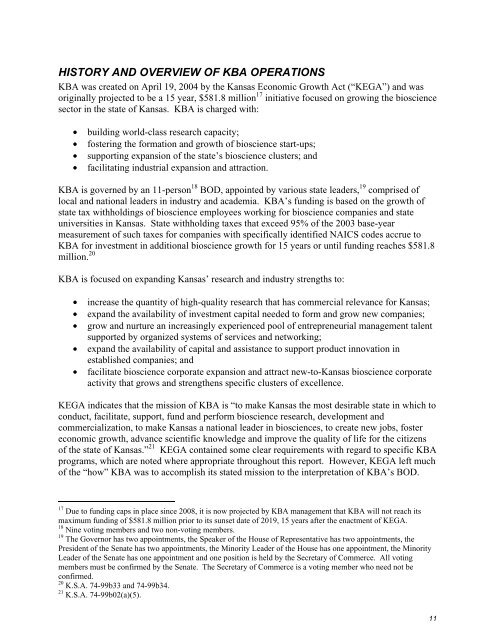Complete 2012 forensic audit documents - Kansas Bioscience ...
Complete 2012 forensic audit documents - Kansas Bioscience ...
Complete 2012 forensic audit documents - Kansas Bioscience ...
You also want an ePaper? Increase the reach of your titles
YUMPU automatically turns print PDFs into web optimized ePapers that Google loves.
HISTORY AND OVERVIEW OF KBA OPERATIONS<br />
KBA was created on April 19, 2004 by the <strong>Kansas</strong> Economic Growth Act (“KEGA”) and was<br />
originally projected to be a 15 year, $581.8 million 17 initiative focused on growing the bioscience<br />
sector in the state of <strong>Kansas</strong>. KBA is charged with:<br />
• building world-class research capacity;<br />
• fostering the formation and growth of bioscience start-ups;<br />
• supporting expansion of the state’s bioscience clusters; and<br />
• facilitating industrial expansion and attraction.<br />
KBA is governed by an 11-person 18 BOD, appointed by various state leaders, 19 comprised of<br />
local and national leaders in industry and academia. KBA’s funding is based on the growth of<br />
state tax withholdings of bioscience employees working for bioscience companies and state<br />
universities in <strong>Kansas</strong>. State withholding taxes that exceed 95% of the 2003 base-year<br />
measurement of such taxes for companies with specifically identified NAICS codes accrue to<br />
KBA for investment in additional bioscience growth for 15 years or until funding reaches $581.8<br />
million. 20<br />
KBA is focused on expanding <strong>Kansas</strong>’ research and industry strengths to:<br />
• increase the quantity of high-quality research that has commercial relevance for <strong>Kansas</strong>;<br />
• expand the availability of investment capital needed to form and grow new companies;<br />
• grow and nurture an increasingly experienced pool of entrepreneurial management talent<br />
supported by organized systems of services and networking;<br />
• expand the availability of capital and assistance to support product innovation in<br />
established companies; and<br />
• facilitate bioscience corporate expansion and attract new-to-<strong>Kansas</strong> bioscience corporate<br />
activity that grows and strengthens specific clusters of excellence.<br />
KEGA indicates that the mission of KBA is “to make <strong>Kansas</strong> the most desirable state in which to<br />
conduct, facilitate, support, fund and perform bioscience research, development and<br />
commercialization, to make <strong>Kansas</strong> a national leader in biosciences, to create new jobs, foster<br />
economic growth, advance scientific knowledge and improve the quality of life for the citizens<br />
of the state of <strong>Kansas</strong>.” 21 KEGA contained some clear requirements with regard to specific KBA<br />
programs, which are noted where appropriate throughout this report. However, KEGA left much<br />
of the “how” KBA was to accomplish its stated mission to the interpretation of KBA’s BOD.<br />
17 Due to funding caps in place since 2008, it is now projected by KBA management that KBA will not reach its<br />
maximum funding of $581.8 million prior to its sunset date of 2019, 15 years after the enactment of KEGA.<br />
18 Nine voting members and two non-voting members.<br />
19 The Governor has two appointments, the Speaker of the House of Representative has two appointments, the<br />
President of the Senate has two appointments, the Minority Leader of the House has one appointment, the Minority<br />
Leader of the Senate has one appointment and one position is held by the Secretary of Commerce. All voting<br />
members must be confirmed by the Senate. The Secretary of Commerce is a voting member who need not be<br />
confirmed.<br />
20 K.S.A. 74-99b33 and 74-99b34.<br />
21 K.S.A. 74-99b02(a)(5).<br />
11


